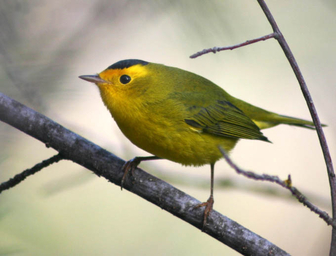Wilson's Warbler
The Wilson's Warbler is a small passerine, ranging from 10–12 centimetres in length, with a wingspan of 14–17 centimetres and a mass of 5–10 grams . It has a plain green-brown back and yellow underparts. The male has a small black cap. Males of the western race W. p. chryseola are greener above and brighter than the eastern race.

Original source: Wilson's Warbler
Author: Michael Woodruff from Spokane, Washington, USA
The Wilson's Warbler is classified as Least Concern. Does not qualify for a more at risk category. Widespread and abundant taxa are included in this category.
The Wilson's Warbler, Wilsonia pusilla, is a small New World warbler. It is primarily greenish above and yellow below, with rounded wings and a long, slim tail. The male has a black crown patch which is greatly reduced or missing entirely in the female. It breeds in across Canada and south through the western United States, and winters from Mexico south through much of Central America. It is a very rare vagrant to western Europe. More
A Wilson's Warbler ready to take a bath at El Polin Spring. Natural History: The Wilson's Warbler feeds primarily on insects, much like the Orange-crowned Warbler. It takes cover in the low canopy layers or forests or shrubs. It nests near water or wet areas on ground or slightly above ground where it breeds from late April to August. General Distribution: In the Presidio, this species can be found in coastal scrub areas, forested areas, and around ornamentals. More
The Wilson's Warbler has a significantly large range reaching up to about 7.9 million square kilometers. This bird is found throughout North America and also in Bahamas, Belize, Bermuda, Cayman Islands, Colombia, Costa Rica, Cuba, El Salvador, Guatemala, Honduras, Nicaragua, Panama, Puerto Rico, Saint Pierre and Miquelon, Turks and Caicos Islands. More
Wilson's Warbler is easily identified by its yellow underparts and black cap. More
The Wilson's Warbler is a small passerine, ranging from 10–12 centimetres (3.9–4.7 in) in length, with a wingspan of 14–17 centimetres (5.5–6.7 in) and a mass of 5–10 grams (0.18–0.35 oz). It has a plain green-brown back and yellow underparts. The male has a small black cap. Males of the western race W. p. chryseola are greener above and brighter than the eastern race. Voice Its song is a series of descending notes. The call is a loud chif. More
When observing Wilson's Warblers in bushes and trees, they flick their wings and tails similar to kinglets. We sometimes see them catch flying insects in the air. More
Wilson's Warblers breed in wet, shrubby areas within forests. In Washington, they are most often found in small breaks in the forest that have dense, moist, shrubby cover, especially willow and alder thickets. These areas can be natural clearings, wetland edges, avalanche chutes, clear-cuts, or stream corridors. During migration and winter, they use similar habitats. More
Wilson's Warbler is a colorful, widespread, relatively well known warbler of riparian, meadow, and humid forest thickets. Its combined breeding, migration, and wintering ranges cover nearly the entire North American continent. It has become something of a flagship species for the conservation of neotropical migrants and is considered a priority in several conservation plans because of widespread population declines and threats to its habitat. More
Wilson's Warbler is very rare in winter in California, but specimens of both pileolata and chryseola have been collected during this season (Dunn and Garrett 1997). MANAGEMENT STATUS: No special management status. HISTORICAL BREEDING DISTRIBUTION CURRENT BREEDING DISTRIBUTION ECOLOGY AVERAGE TERRITORY SIZE In oak-bay-laurel habitat in Marin County, Stewart (1973) found 24 territories averaging 0.57 ha (1.3 ac) and ranging between 0.2-1.3 ha (0.5-3.2 ac). More
Wilson's Warbler - Wilsonia pusillaA small, very active warbler of thickets and woodland edges, Wilson's Warblers are often more readily identified by birders due to their habit of foraging quite low in forest vegetation. They can be found nearly anywhere in the continental United States during their spring migration, but are generally much more common in the West than in the East. They tend to have increasingly brilliant plumage the as you move westward in the continent. More
Wilson's Warblers usually forage within ten feet of the ground, darting after flying insects or hovering in mid-air to glean insects from leaves. They also sometimes feed on the ground, probing the leaf litter for prey. The tiny Wilson's Warbler is an energetic bird that often makes a circular motion with its tail or wags it up and down. This tame and curious bird will usually approach at the sound of birders' spishing. More
Swainson's thrush, Wilson's warbler, common yellowthroat and Lincoln's sparrowUPS AND DOWNS by The Register-Guard (Eugene, OR)The agroforest setting of a traditionally managed coffee farm might well provide a less stressful setting for magnolia and Wilson's warblers.A rich brew from the shade by Rice, Robert A. / Americas (English Edition)Spring foliage shelters western tanagers; and orange-crowned, yellow, yellow-rumped, MacGillivray's, and Wilson's warblers, while bushtits and spotted towhees sing in brush and rufous hummingbirds flit in wildflowers. More
Wilson's Warbler"Partly because of his unseasonable dalliance, this tiny golden fragment becomes one of the most conspicuous of migrants..." -Dawson Identification These are small warblers (3 3/4") that are yellow underneath and olive above. Males sport a distinct black cap which may be mottled or absent in females. Wilson's Warblers have long dark tails without any white or yellow patches. Subspecies Of three recognized subspecies of Wilson's Warblers, only one, W. p. More

Original source: Jeff Whitlock
Author: Jeff Whitlock
Permission: Some rights reserved
Family : Parulidae
Genus : Wilsonia
Species : pusilla
Authority : (Wilson, 1811)

